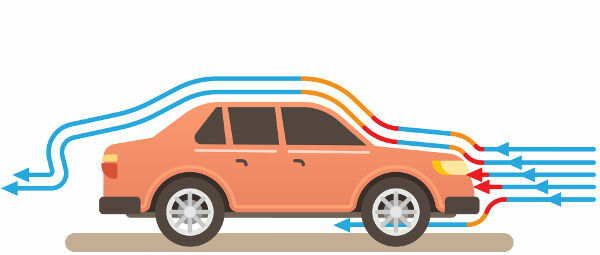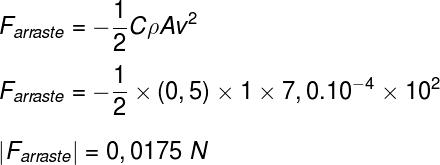The drag is a friction force arising through the friction between the body and the fluid. This force acts in a direction parallel to the surface of the body and, in many cases, is proportional to the square of the speed at which the body moves relative to the fluid.
What is drag force?
There are three different types of drag forces, these forces are called surface drag, shape drag and wave drag.
In general terms, the drag force, also known as resistanceoffluid, so much can be aerodynamics like hydrodynamics, for cases where the body moves in gaseous and liquid media, respectively.

The drag is, in most cases, proportional to the square of the speedof the body in relation to the environment in which it moves, but also directly proportional to the area of the body transverse to the flow of the fluid lines.
In addition to these factors, the shape of the body is capable of greatly altering the way the drag force acts on it, all of which depends on how the fluid lines flow. We'll explain what they are later on.
Lookalso: Everything you need to know about hydrostatics
fluid lines
fluid lines are features used to facilitate understanding of drag forces. These are geometric constructions, also called fluid dynamic lines. They indicate how the layers of a fluid move.
In the case where the fluid dynamic lines are superimposed and parallel, the fluid flow is laminar and very little drag force is exerted on a body moving over it. In this case, there is only friction between the layers of the fluid, so we say that it has only viscosity.

When the fluid dynamic lines are not parallel to each other, we say that the flow of fluid passing through the body is chaotic. This type of flow is capable of greatly reduce the speed at which the body moves through this medium, resembling the case where a swimmer tries to swim against the current of a turbulent river.
surface drag
Surface drag is that force caused by moving a body in directionopposite to the fluid. It arises thanks to the contact between the fluid and the body, through an immediate contact layer on its surface.
This type of drag arises because of the roughness of a body surface that moves in the fluid, since the roughness itself provides a areaincontactbigger between both.
Surface dragging is widely explored in professional swimming competitions, what is used clothessmooth, able to considerably reduce the fluid drag while the swimmer moves in liquid medium.
Lookalso: How does the phenomenon of convection occur and how it works
shape drag
The shape drag results from a differencein pressure between different parts of a body moving through a fluid.
When a body moves at a high enough speed through a fluid, just behind it a turbulent region, whose pressure is less than the pressure in front of the body. This pressure difference results in a dragcontraryto thesenseof body movement.
In order to reduce surface drag, objects that are designed to travel in fluids are drawn in aerodynamic shapes, and this condition is obtained when the area of the body that is perpendicular to the flow of the lines of fluid.
Lookalso: Thermal equilibrium - learn to calculate equilibrium temperature
wave drag
Wave drag only occurs when any body moves near the surface of the water, as when swimmers pushthe water down, being pushedforup, but also losing part of your kinetic energy because of the “barrier” of water that forms in front of it.
Another example would be a ship, which forms drag waves in front of its bow when in motion. Wave drag does not occur when bodies move completely immersed in water.

Drag force formula
Check the formula used to calculate the drag force:

Ç – drag coefficient
ρ – fluid density (kg/m³)
THE – area of the body transverse to fluid dynamic lines (m²)
v – body speed (m/s)
The formula relates the drag force to the density of the middle, the cross-sectional area of the body and the square of the velocity of that body, but it also refers to a drag coefficient C — a dimensionless quantity that depends directly on the shape of the object, in the case of spherical objects, for example. The drag coefficient is equal to 0.5.
Lookalso: Physics Discoveries That Happened By Accident
terminal speed
When an object of significant size falls from great heights, the drag force balances with the force Weight of the object. In this way, the resulting force on the object becomes null and it continues its movement in a straight path, with constant speed, according to the Newton's 1st Law, the law of inertia.
The speed at which an object hits the ground after being released into the air, called the velocityterminal, can be calculated using the following expression, note:

Lookalso:How to Solve Newton's Law Exercises
Solved exercises on drag force
Question 1) A spherical object (C = 0.5) with a cross-sectional area of 7.0 cm² (7.0.10-4 m²) travels through the air at a speed of 10.0 m/s. Knowing that the density of air is approximately 1.0 kg/m³ and that the density of the object is 800 kg/m³, determine the magnitude of the drag force on that object.
a) 0.750 N
b) 0.0550 N
c) 0.0175 N
d) 0.2250 N
e) 0.5550 N
Template: Letter C
Resolution:
The exercise asks us to calculate the drag force intensity, to do so, just replace the data informed in the formula, note:

Question 2) Review the statements about the drag force, then tick the correct alternative:
I - The drag force is proportional to the square of the body's speed.
II - The greater the density of the medium, the greater the intensity of the drag force exerted by a body that crosses it.
III - The terminal velocity of a body moving in a fluid medium does not depend on the object's mass.
They are true:
a) Only I
b) I and II
c) I, II and III
d) Only II
e) II and III
Template: Letter B
Resolution:
The correct alternatives are I and II. Regarding alternative II, the density of the medium is directly proportional to the drag force, so the correct alternative is the letter b.
Question 3) A body of mass m is released from a certain height in relation to the ground, in a region where there is the presence of atmospheric gases, falling under the effect of its weight and the drag force of the air. A second body, of the same shape and size, but four times the mass, is dropped from the same height under the same conditions. Determine the relationship between the terminal velocity of the second body (v') and the terminal velocity of the first body (v).
a) v' = 3v
b) v' = v/4
c) v' = 4v
d) v' = v/2
e) v' = 16v
Template: Letter C
Resolution:
Since the mass of the second body is four times the mass of the first body and the terminal velocity depends on the square root of the mass, the terminal velocity of the body that is four times as massive will be twice as large, ie: v' = 4v.
By Rafael Hellerbrock
Physics teacher
